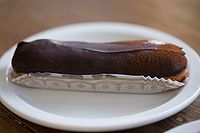- Éclair (pastry)
-
For other uses, see Éclair (disambiguation).
An éclair is a pastry made with choux dough filled with a cream and topped with icing.
The dough, which is the same as that used for profiterole, is piped into an oblong shape with a pastry bag and baked until it is crisp and hollow inside. Once cool, the pastry then is filled with a coffee- or chocolate-flavoured[1] pastry cream (crème pâtissière), custard, whipped cream, or chiboust cream; and iced with fondant icing.[2] Other fillings include pistachio- and rum-flavoured custard, fruit-flavoured fillings, or chestnut purée. The icing is sometimes caramel, in which case the dessert may be called a bâton de Jacob.[3]
Other old variants use petit four dough.
Contents
Etymology
The word éclair comes directly from a French word whose chief meaning is "lightning" or "flash of lightning." No one is sure why a pastry was named after lightning. Some say the lightness of the cream puff and its soft filling is the reason for the name. Perhaps more likely its richness and oblong shape, easily held in one hand, compel a person to eat it in a flash.[4]
History of the éclair
The éclair probably originated in France during the nineteenth century. It is a popular type of cake served all over the world. The word is first attested both in English and in French in the 1860s.[5][6] Some food historians speculate that éclairs were first made by Antonin Carême (1784–1833), the famous French chef.[citation needed] The first known English-language recipe for éclairs appears in the Boston Cooking School Cook Book by Mrs. D.A. Lincoln, published in 1884.
Éclair is French for "lightning," though the connection is obscure.
Outside France
In some parts of the United States, Long Johns are marketed under the name éclairs, though the two are not identical. A Long John uses donut pastry and is typically filled with vanilla pudding, making it a simpler and inexpensive alternative to the éclair.
Notes
- ^ Montagné, Prosper, Larousse gastronomique : the new American edition of the world's greatest culinary encyclopedia, Jenifer Harvey Lang, ed., New York: Crown Publishers, 1988, p. 401 ISBN 978-0-517-57032-6
- ^ Ibid.
- ^ (Montagné 1961, Éclair)
- ^ http://www.wordcentral.com/cgi-bin/student?eclair
- ^ Oxford English Dictionary, 1861. Petit Larousse, 1863.
- ^ Gouffé, Jules (1873). "Entremets détachés" (in French) (PDF). Le Livre de Pâtisserie. Paris: Hachette. p. 288. http://gallica.bnf.fr/ark:/12148/bpt6k107860n.image.f310. Retrieved 2009-03-24. "On a changé, depuis une vingtaine d'années, le nom de ces gâteaux [pains à la duchesse] : on les désigne actuellement sous le nom d'éclairs."
References
- Jules Gouffé, Le livre de pâtisserie, 1873 [1], Deuxième Partie, Chapitre IX, "Pains à la duchesse au café"
- Prosper Montagné, Larousse Gastronomique, The Encyclopedia of Wine, Food & Cookery (English translation), 1961
External links
Categories:- French pastry
- Custard desserts
- Chocolate desserts
- Pastry
Wikimedia Foundation. 2010.


